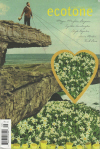Ecotone – Spring 2013
In his comic strip in this issue of ecotone, Jeff Koterba tells readers that people move through life “never imagining that we carry the bonds of home, wherever we go.” This idea is a connecting thread, in keeping with the theme of home that Editor David Gessner tells us has been “with us from the beginning.” He also writes that “Human beings are animals,” and “we are living in a time of deep danger and uncertainty,” and “making a home in this uncertain world has never been harder than it is now.” Readers of this issue will be certain of these truths as they are uncovered and rediscovered by writers of fiction, nonfiction, and poetry in this spring offering from the magazine whose title means “a place of danger or opportunity.” This issue brings it all back home for the editors, writers, and fortunate readers.
In his comic strip in this issue of ecotone, Jeff Koterba tells readers that people move through life “never imagining that we carry the bonds of home, wherever we go.” This idea is a connecting thread, in keeping with the theme of home that Editor David Gessner tells us has been “with us from the beginning.” He also writes that “Human beings are animals,” and “we are living in a time of deep danger and uncertainty,” and “making a home in this uncertain world has never been harder than it is now.” Readers of this issue will be certain of these truths as they are uncovered and rediscovered by writers of fiction, nonfiction, and poetry in this spring offering from the magazine whose title means “a place of danger or opportunity.” This issue brings it all back home for the editors, writers, and fortunate readers.
Danger is clearly evident in the opening piece of fiction, “Animals” by Chaz Reetz-Laiolo. Adept at diction and dialogue, Reetz-Laiolo creates the world of a commune in the here and now, revisited, with all of the trappings that communes always seem to have while appearing to be safe havens from the outside. Aaron brings his girlfriend, Darly, to spend time in this place that is clearly significant to his life. He knows the others there intimately—they’ve seen each other naked—and Aaron introduces Darly to Ford in the first glimpse of exhibitionism: “He was tall and half-undressed at the washing machine, his high, hairy buttocks out from under his T-shirt. He clapped Aaron on the chest, and Aaron could feel Darly trying not to look at his bunched penis.” This preview foreshadows the characters’ attempt to retrieve a feeling, elusive to them now, of the home they once shared in wild abandon. This is a story of nostalgia, community, and terror that is a fitting first step, a foray into the comfortable idea of home, only to have it pulled from the floor beneath feet thought firmly planted.
Poems and essays intermingle throughout the issue and reveal images of home or the loss of home, of humans traveling or existing far from home, of places that may only be temporary or indefinable homes. Jill Sisson Quinn, in her nonfiction piece “The Myth of Home” writes, “research shows that, at least very early in life, the place we love most is a place we may have never set foot in.” This knowledge, this sense of place is the quality inherent in the selections of this issue of ectone, found in Lisa Fay Coutley’s two poems that are companion pieces with a poet and an astronaut as central characters experiencing a long-distance relationship, a marrying of earth and sky. The narrative of each cascades down the page in rivulets, in a waterfall of space, time, geography, and human contact that depicts art and science and their interdependence and influence, showing they are “growing closer together in lesser conditions / spinning uncertain & dumb & out of time / until bone is skin is air is fire.” Coutley’s lines are true art that repeats the necessary and illuminates certainty and uncertainty.
The themes of home, place, and territory are major in this issue, but lying closely in the undergrowth is another theme: the theme of water, of fluidity, of “the river in spate,” from Ciaran Berry’s poem “Shannon,” or the lake that “believes it is the ocean,” in Quinn’s piece. From a swimming pool in “Animals” to the “frozen villages of Russia” in Jeff Koterba’s “Russian Air” to John Lane’s “confluence where the creek that drains Calhoun Lakes enters Lawson’s Fork,” there is a subliminal, but not so very subtle, message of continuance, one that is worth exploring further to find where all the textual water meets the literary ocean.
Readers should also note Paula Rebsom’s art installation, “If we Lived Here,” and the maps on pages that are “River Bend Chronicle Geography” by Ben Miller and Dale Williams. Each of these pieces at once entertains, informs, stimulates, and demands attention.
In “Of Frisbees, Physarum, & Cow Paths: A Creative Code,” David Oates writes:
A desire path is what every good piece of imagining follows. It might be a very smart piece—an experiment, an essay, a painting; it might be full of information and intellect and cold logic. But I guarantee that comes to be born—like all living things—from a burst of pleasure. Sheer, randy pleasure.
Discovering this is a kind of homecoming, a joyous event, as David Gessner concludes; readers will recognize this and find their paths as they follow the routes laid out by the magazine’s selections. This issue of ecotone, they will find, delivers on its name, and gives readers glimpses of dwellings and emotional atmospheres on the earth and in the spaces within, above, and around it. Readers need only to follow the bread crumbs.
[www.ecotonejournal.com]





